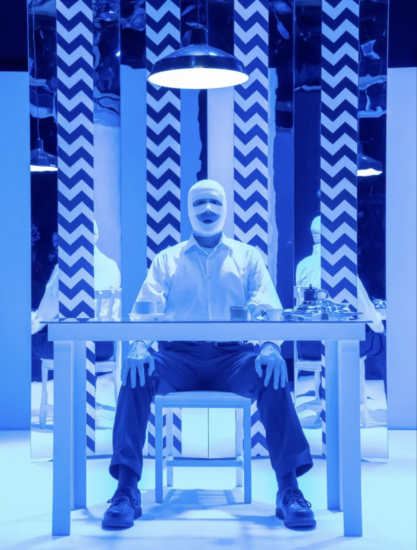
Christopher Caines stars as the title character in Ping Chong’s mesmerizing update of Lazarus
LAZARUS 1972–2022
La MaMa Downstairs Theater
66 East Fourth St. between Second & Third Aves.
Thursday – Sunday through October 16, $25-$30
www.lamama.org
www.pingchong.org
For his final work as artistic director for his troupe, Ping Chong revisits his past while looking to the future in Lazarus 1972–2022, a contemporary reimagining of his first independent piece. In 1972, Ping presented Lazarus at Meredith Monk’s loft studio; as part of Ping Chong and Company’s fiftieth anniversary, the thrilling update is running at La MaMa, just a few blocks from that studio, through October 16.
The evening begins with a film of the stars in the galaxy, followed by a video countdown of the Toronto-born Ping’s previous works. Then Watoko Ueno’s delicate, enchanting set is intricately put together by two women (Chaesong Kim and Nancy McArthur) dressed all in black who bring in a white glass table and a white chair and place dining items on them — a coffee cup and saucer, salt and pepper shakers, a serving tray, silverware in a napkin — arranging and rearranging them with great delicacy, each making a loud noise as they are put on the table. Behind the table is a backdrop with alternating vertical panels. A hanging lamp is occasionally set in motion, moving back and forth like a pendulum clock running out of time as it slows down. (The haunting lighting, which turns from white to red to blue to pitch-black, is by Hao Bai, with expert sound design by Ernesto Valenzuela.)
Eventually, Lazarus (Christopher Caines) enters the room; he is wearing black pants, a white button-down shirt, and black shoes, his face covered in white bandages except for his eyes and mouth. He evokes both Claude Rains in The Invisible Man and Edith Scob in Eyes without a Face, another character whose true self goes unseen by the world. In this case, Lazarus has risen to life in 2022 New York City and feels alienated from a society not so quick to welcome strangers, echoing Ping’s experience when he moved out of Chinatown, where he was raised. Lazarus deliberately repositions the items on the table and prepares to eat, but he is soon distracted.
Over the course of about an hour, Lazarus meets a mysterious lady in red (Jeannie Hutchins) and another young woman in black (Tiffany Tan), becomes a puppet, encounters a strange truck, and considers what is next for him in this unyielding city, which at one point flies past him on multiple screens. (The projections are by Kate Freer, with costumes by Stefani Mar.) The only words are spoken in voiceover by Louise Smith or Ping (“There is a room; there is nothing in the room.”); there is no dialogue, only sound, light, and movement in a mesmerizingly beautiful piece.
The Canadian-born Caines, who runs his own dance company, has performed previously with Ping and is hypnotic as Lazarus; you can feel his alienation and suspicion as his eyes and body shift to surprise noises or he just stands tall and still, waiting for something to happen to break him out of his loneliness. But don’t let me mislead you; the show is also very funny.
“Time passes, and with time passing the poignancy of loss multiplies, which is to say Lazarus has lived the fullness of life through time,” Ping writes in a program note. “By now, it must be obvious that I am Lazarus and Lazarus is me. The theme of Lazarus, the theme of Otherness, runs through all my work. Who could be more Other than Lazarus. . . . I have chosen to complete my life as an artist with this work that started it all. Coming full circle seemed appropriate.”
Lazarus 1972–2022 is a fitting finale for Ping, a longtime leader in the avant-garde theater that rose up in downtown New York City in the 1970s and who is now saying farewell having come full circle, for all our benefit.